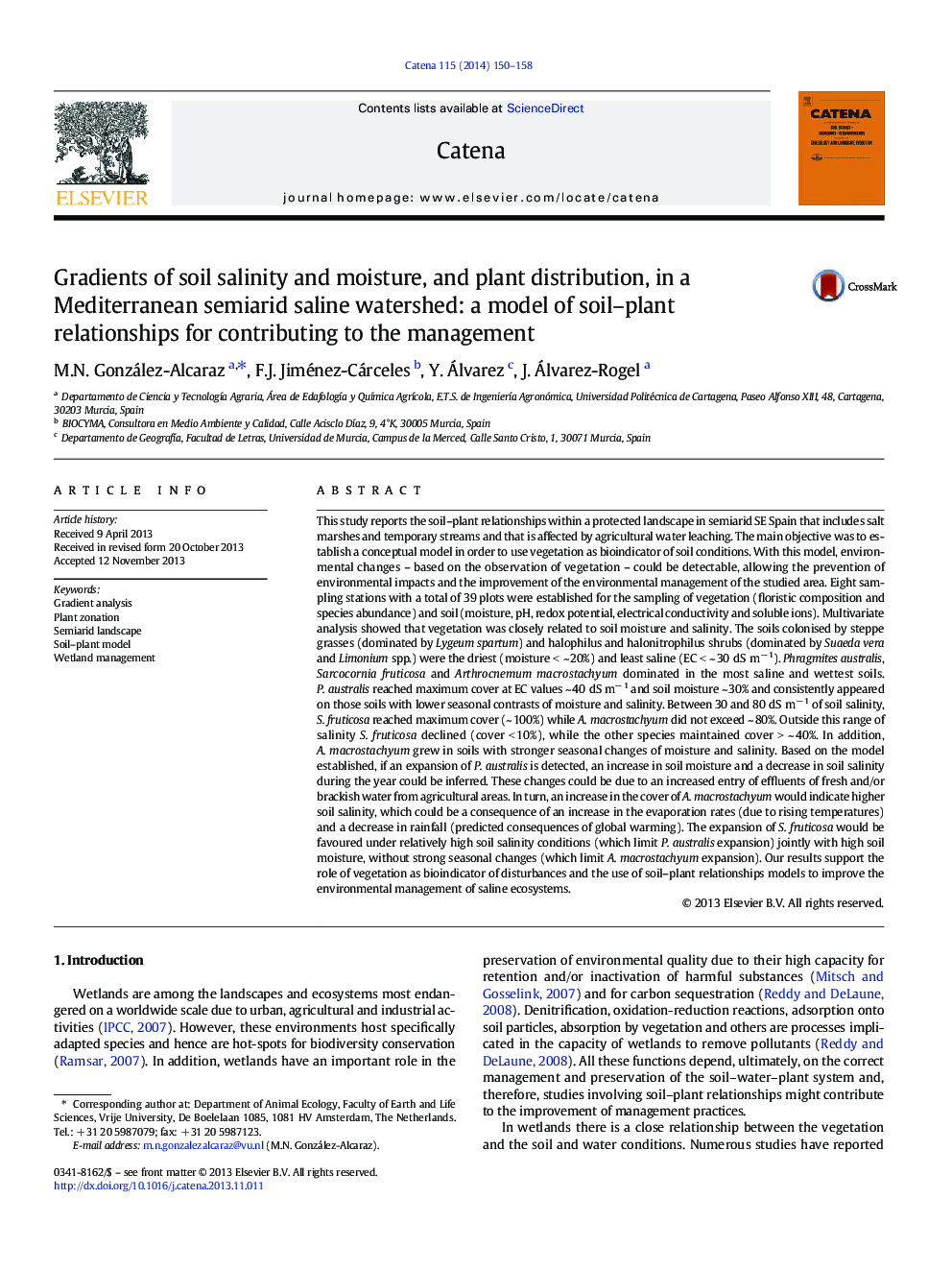| کد مقاله | کد نشریه | سال انتشار | مقاله انگلیسی | نسخه تمام متن |
|---|---|---|---|---|
| 6408106 | 1629237 | 2014 | 9 صفحه PDF | دانلود رایگان |

- Vegetation distribution was closely related to soil moisture and salinity.
- Lygeum spartum, Suaeda vera and Limonium spp. grew in drier and least saline soils.
- Phragmites australis dominated in soils with EC values ~ 40 dS mâ 1 and moisture ~ 30%.
- Arthrocnemum macrostachyum grew under stronger changes of soil moisture and salinity.
- Soil-plant relation helps detect disturbances and improves ecosystems management.
This study reports the soil-plant relationships within a protected landscape in semiarid SE Spain that includes salt marshes and temporary streams and that is affected by agricultural water leaching. The main objective was to establish a conceptual model in order to use vegetation as bioindicator of soil conditions. With this model, environmental changes - based on the observation of vegetation - could be detectable, allowing the prevention of environmental impacts and the improvement of the environmental management of the studied area. Eight sampling stations with a total of 39 plots were established for the sampling of vegetation (floristic composition and species abundance) and soil (moisture, pH, redox potential, electrical conductivity and soluble ions). Multivariate analysis showed that vegetation was closely related to soil moisture and salinity. The soils colonised by steppe grasses (dominated by Lygeum spartum) and halophilus and halonitrophilus shrubs (dominated by Suaeda vera and Limonium spp.) were the driest (moisture < ~ 20%) and least saline (EC < ~ 30 dS mâ 1). Phragmites australis, Sarcocornia fruticosa and Arthrocnemum macrostachyum dominated in the most saline and wettest soils. P. australis reached maximum cover at EC values ~ 40 dS mâ 1 and soil moisture ~ 30% and consistently appeared on those soils with lower seasonal contrasts of moisture and salinity. Between 30 and 80 dS mâ 1 of soil salinity, S. fruticosa reached maximum cover (~ 100%) while A. macrostachyum did not exceed ~ 80%. Outside this range of salinity S. fruticosa declined (cover < 10%), while the other species maintained cover > ~ 40%. In addition, A. macrostachyum grew in soils with stronger seasonal changes of moisture and salinity. Based on the model established, if an expansion of P. australis is detected, an increase in soil moisture and a decrease in soil salinity during the year could be inferred. These changes could be due to an increased entry of effluents of fresh and/or brackish water from agricultural areas. In turn, an increase in the cover of A. macrostachyum would indicate higher soil salinity, which could be a consequence of an increase in the evaporation rates (due to rising temperatures) and a decrease in rainfall (predicted consequences of global warming). The expansion of S. fruticosa would be favoured under relatively high soil salinity conditions (which limit P. australis expansion) jointly with high soil moisture, without strong seasonal changes (which limit A. macrostachyum expansion). Our results support the role of vegetation as bioindicator of disturbances and the use of soil-plant relationships models to improve the environmental management of saline ecosystems.
Journal: CATENA - Volume 115, April 2014, Pages 150-158